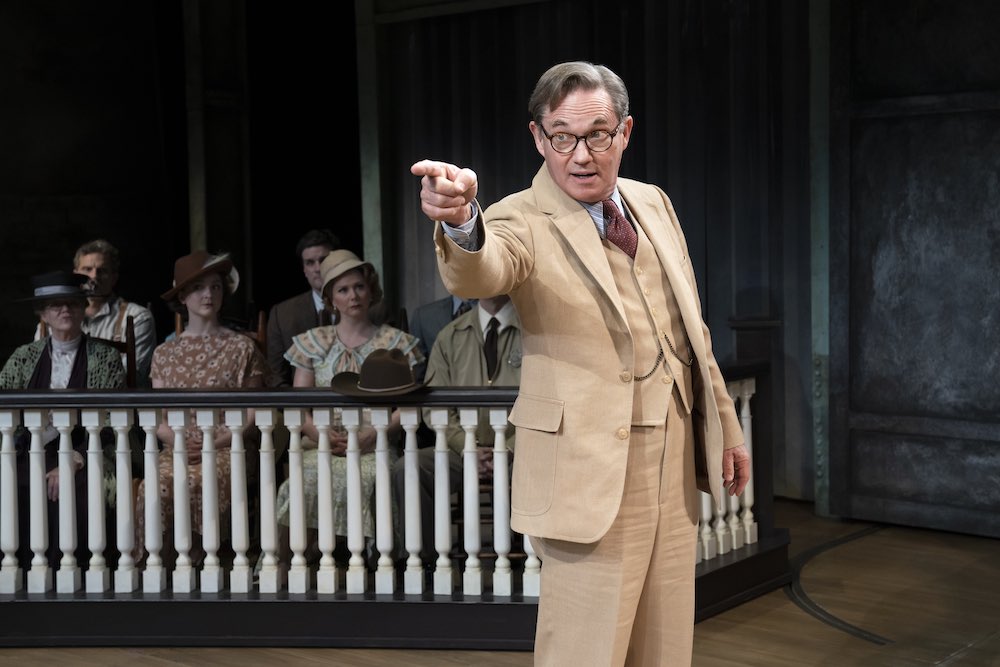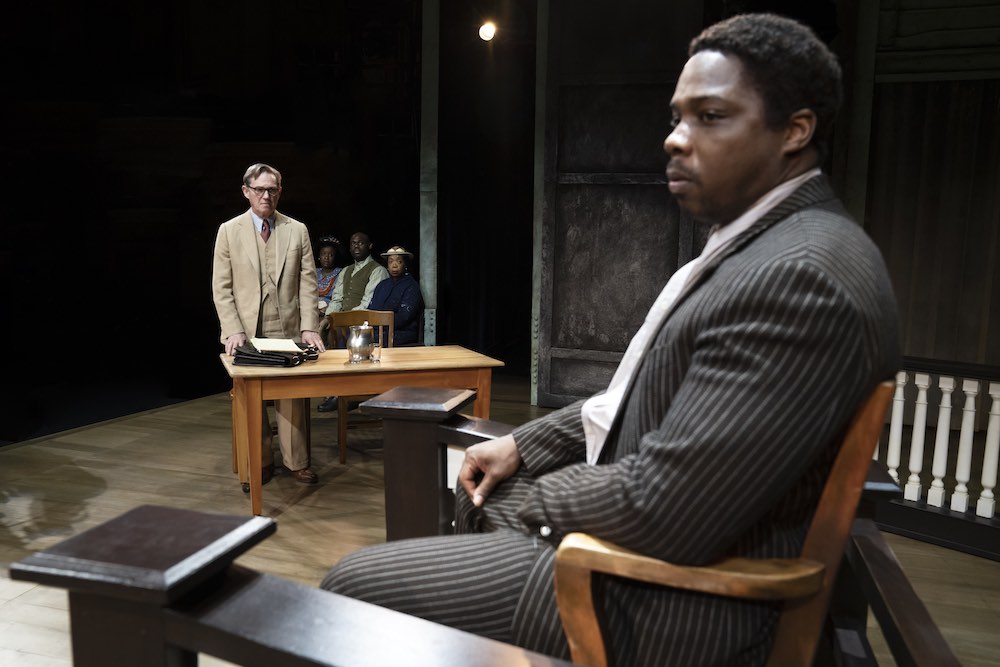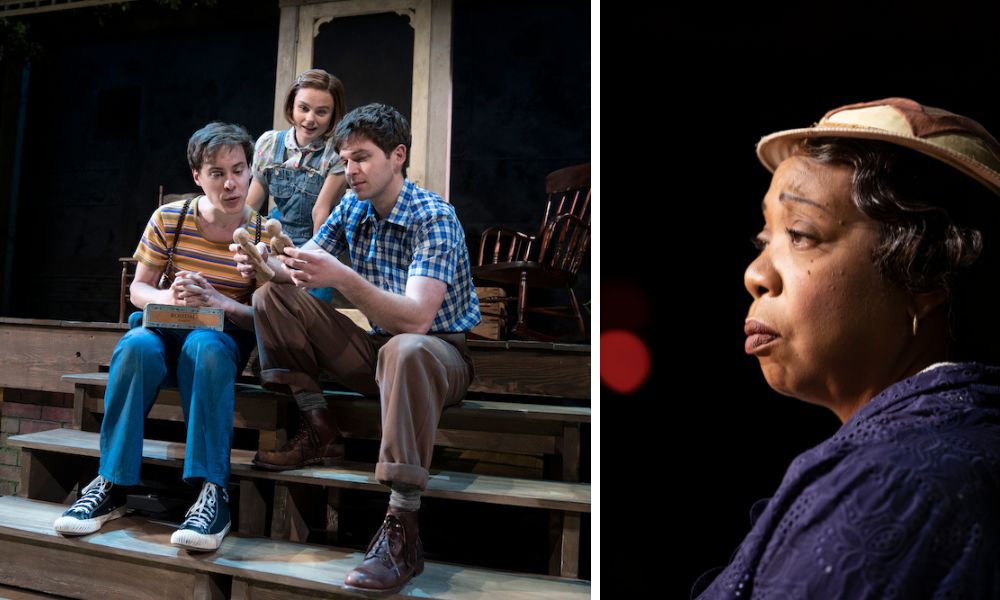(This is the first of two DC Theater Arts articles about the national touring production now playing in DC at the Kennedy Center. See also Aaron Sorkin’s scintillating rethink of ‘To Kill a Mockingbird’ at Kennedy Center by John Stoltenberg.)
The jury box is empty. As the trial of Tom Robinson proceeds, a low partition demarcates the area where a jury would sit, but there are no jurors, nor even chairs, behind it. To whom is defense counsel Atticus Finch addressing his arguments?
By the time Atticus makes his impassioned closing argument in the case, the answer is clear: it is we, the audience, who are the jury. As Atticus, an effective Richard Thomas, delivers the address on the downstage apron, straight out to the audience. It’s not just about a Black man being charged with a crime he did not commit; it’s about the decisions we as Americans are called upon to make at the present moment.

The official title of the play, now in a touring engagement at the Kennedy Center, is Harper Lee’s To Kill a Mockingbird, but make no mistake, this is fully Aaron Sorkin’s To Kill a Mockingbird. Sorkin has not so much adapted Harper Lee’s famous novel as reimagined it as a new work.
The novel and the renowned movie made from it are about the ways Finch’s children see and live life in small town Alabama in the mid-1930s. The novel lives in that time period, seen through the eyes of the 9-year-old Scout Finch. Its tone is elegiac, of a father’s love and a child’s growth in the shelter of that love. It is mournfully critical of but does not seek to overthrow the pervasive racism of the time and place.
Just as The Crucible though set in 1692 Massachusetts is about the Red Scare of the early 1950s, Sorkin’s Mockingbird is set in the mid-1930s but is about, as the playwright has said, the nation’s 21st-century racial and political turmoil. The play’s tone is urgent and exhortative, emphasizing the need to take sides, to fight against racism and ignorance.

The differences are most stark in the contrasting portrayals of Atticus. In the novel and movie, he is consistently admirable, a truly good man lacking a discernible character arc. A paragon of self-control, he never raises his voice. He knows from the beginning that an all-white jury will convict a Black man accused of rape by a white woman regardless of the evidence, but he feels compelled to have the truth told in public.
Sorkin’s Atticus begins as a painfully naïve figure, wanting to give everyone the benefit of the doubt, trying to understand even the worst of people by walking a while in their shoes. He is confident in his belief that the good townspeople he knows will of course follow the evidence and acquit his client. So firmly does he believe this that he convinces Robinson (Yaegel T. Welch) to take the death penalty case to trial rather than accept a plea bargain involving an 18-year sentence (an option not available to Robinson in the novel). Sorkin intentionally gives Robinson noticeably greater agency in making decisions about his fate than does Lee’s novel.
The play’s Atticus initially fails to discern what is truly at stake. To his sorrow, he learns better. He has to earn goodness. His growth makes him a more compelling stage character. In the latter stages of his character arc, he is finally able to affirm that he is superior to the play’s villain, the no-good Bob Ewell (Joey Collins), and to take strong, physical action against him. Some people must be fought, not just understood. At the climax of the trial, Atticus finds that he must raise his voice.
Ewell’s racism, simply organic to his being “white trash” as the novel’s characters view him, is much more explicitly ideological in the play. By the time he finishes a tirade about having to protect his race, there is little doubt that Sorkin’s Ewell could fit readily into a contemporary white nationalist rally. If there had been MAGA hats in 1934, Ewell would have worn one. Sorkin has said, in fact, that he borrowed much of Ewell’s dialogue from commenters on the Breitbart website.
A striking innovation in the play is that, rather than having the narrator role belong solely to Scout (Melanie Moore), she shares that role with her brother, Jem (Justin Mark), and their friend Dill (Steven Lee Johnson). All three are young adult actors playing their characters less as young children than as teenagers, though they run everywhere they go as if they were in fact younger.
Sorkin’s script gives the kids a few too many “tell rather than show” moments for comfort, and they more often report on the happenings of the story than fully experience them. But they have an especially effective moment when they convey words expressed in the ASL signing of Anthony Natale, a deaf actor playing Link Deas, a sympathetic witness who is a composite of two characters from the novel.

A key thread tying the novel together is the children’s wonderment and fear concerning the mysterious Boo Radley. Given the play’s strong, central focus on the trial, Sorkin’s play deemphasizes the Boo Radley element, in the process losing some of the novel’s emotional power.
Sorkin gives Calpurnia (Jacqueline Williams), Atticus’s Black housekeeper, a more assertive role than does the novel, having her tellingly challenge her employer’s racial complacency. Atticus may think he knows what the white people of the town are like; they don’t know them like she knows them.
A sweet casting move gives Mary Badham, who played Scout in the 1960s film, a brief role as Mrs. Dubose, a sick, mean old lady who lives near the Finches. But the play whiffs on what made her role in the novel morally significant, when Atticus requires Jem to read aloud to her each day as she tries to break an addiction to morphine before dying.
Bartlett Sher’s direction makes good, understandable sense of the nonlinear, back-and-forth-in-time, structure of Sorkin’s script, aided, perhaps, by the fact that it would be a rare audience member who did not know how the story proceeds. He gives the cast plenty of room to take advantage of the humorous one-liners characteristic of Sorkin’s writing since his West Wing days. The show never lags and maintains the audience’s interest throughout.
This is not the first attempt at making a play from Harper Lee’s novel. A far more literal adaptation, by Christopher Sergel, has been making the rounds of school and community theater stages since the early 1990s. I’ve seen it. It’s deadly dull. Sorkin’s play is a far superior piece of theater, and does a sterling job of using the 1930s events depicted in the novel to illuminate what’s important today. Echoing the time-honored phrase used at the beginning of court hearings as the judge enters, Scout uses “All rise” as a call to action at the end of the play. She’s worth listening to.
Running Time: Two hours 55 minutes, including one 15-minute intermission.
Harper Lee’s To Kill a Mockingbird plays through July 10, 2022, in the Kennedy Center Opera House, 2700 F Street NW, Washington, DC. Tickets ($49–$199) are available at the box office, online, or by calling (202) 467-4600 or (800) 444-1324.
The program for To Kill a Mockingbird is online here.
COVID Safety: Masks are required for all patrons inside all theaters during performances at the Kennedy Center unless actively eating or drinking. Kennedy Center’s complete COVID Safety Plan is here.




